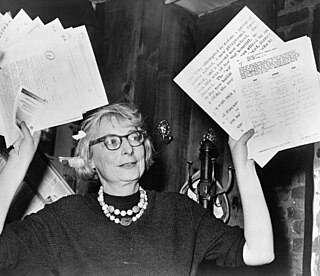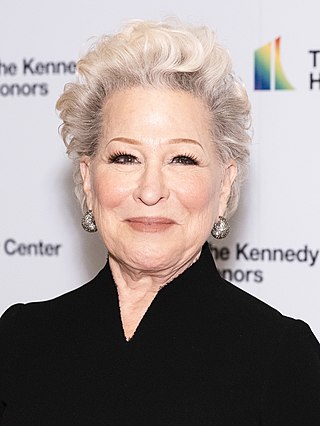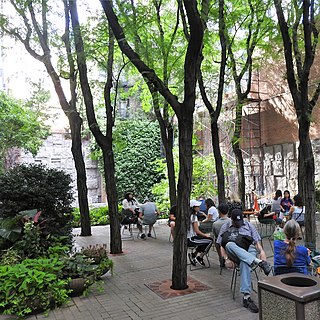
Battery Park City is a mainly residential 92-acre (37 ha) planned community and neighborhood on the west side of the southern tip of the island of Manhattan in New York City. It is bounded by the Hudson River on the west, the Hudson River shoreline on the north and south, and the West Side Highway on the east. The neighborhood is named for the Battery, formerly known as Battery Park, located directly to the south.

Jane Jacobs was an American-Canadian journalist, author, theorist, and activist who influenced urban studies, sociology, and economics. Her book The Death and Life of Great American Cities (1961) argued that "urban renewal" and "slum clearance" did not respect the needs of city-dwellers.

Washington Heights is a neighborhood in the northern part of the borough of Manhattan in New York City. It is named for Fort Washington, a fortification constructed at the highest natural point on Manhattan by Continental Army troops to defend the area from the British forces during the American Revolutionary War. Washington Heights is bordered by Inwood to the north along Dyckman Street, by Harlem to the south along 155th Street, by the Harlem River and Coogan's Bluff to the east, and by the Hudson River to the west.

Bette Midler is an American singer, actress, comedian and author. Throughout her career, which spans over five decades, Midler has received numerous accolades, including four Golden Globe Awards, three Grammy Awards, three Primetime Emmy Awards, two Tony Awards and a Kennedy Center Honor, in addition to nominations for two Academy Awards and a British Academy Film Award.

Fort Tryon Park is a public park located in the Washington Heights and Inwood neighborhoods of the borough of Manhattan in New York City. The 67-acre (27 ha) park is situated on a ridge in Upper Manhattan, close to the Hudson River to the west. It extends mostly from 192nd Street in the south to Riverside Drive in the north, and from Broadway in the east to the Henry Hudson Parkway in the west. The main entrance to the park is at Margaret Corbin Circle, at the intersection of Fort Washington Avenue and Cabrini Boulevard.

The Rose Fitzgerald Kennedy Greenway is a linear park located in several Downtown Boston neighborhoods. It consists of landscaped gardens, promenades, plazas, fountains, art, and specialty lighting systems that stretch over one mile through Chinatown, the Financial District, the Waterfront, and North End neighborhoods. Officially opened in October 2008, the 17-acre Greenway sits on land created from demolition of the John F. Fitzgerald Expressway as part of the Big Dig project.

A community garden is a piece of land gardened or cultivated by a group of people individually or collectively. Normally in community gardens, the land is divided into individual plots. Each individual gardener is responsible for their own plot and the yielding or the production of which belongs to the individual. In collective gardens the piece of land is not divided. A group of people cultivate it together and the harvest belongs to all participants. Around the world, community gardens exist in various forms, it can be located in the proximity of neighborhoods or on balconies and rooftops. Its size can vary greatly from one to another.

The Death and Life of Great American Cities is a 1961 book by writer and activist Jane Jacobs. The book is a critique of 1950s urban planning policy, which it holds responsible for the decline of many city neighborhoods in the United States. The book is Jacobs' best-known and most influential work.

Hudson Heights is a residential neighborhood within Washington Heights in Upper Manhattan, New York City. Most residences are apartment buildings, many of which are cooperatives, and most were constructed in the 1920s through 1940s. The Art Deco style is prominent, along with Tudor Revival. Notable complexes include Hudson View Gardens and Castle Village, which were both developed by Dr. Charles V. Paterno, and were designed by George F. Pelham and his son, George F. Pelham, Jr., respectively.

Fort Washington Park is a public park located in the Washington Heights section of Upper Manhattan in New York City. It runs along the banks of the Hudson River next to Riverside Drive and the Henry Hudson Parkway from West 155th Street to Dyckman Street. The George Washington Bridge crosses above the park; below the bridge is a small point of land called Jeffrey's Hook, which is the site of the Little Red Lighthouse.

Cabrini Boulevard spans the Manhattan neighborhood of Hudson Heights, running from West 177th Street in the south, near the George Washington Bridge, to Fort Tryon Park in the north, along an escarpment of Manhattan schist overlooking the Henry Hudson Parkway and the Hudson River. It is the westernmost city street in the neighborhood except for a one block loop formed by Chittenden Avenue between West 186th and 187th Streets.

Urban horticulture is the science and study of the growing plants in an urban environment. It focuses on the functional use of horticulture so as to maintain and improve the surrounding urban area. Urban horticulture has seen an increase in attention with the global trend of urbanization and works to study the harvest, aesthetic, architectural, recreational and psychological purposes and effects of plants in urban environments.

Chatham Village is a community within the larger Mount Washington neighborhood of the city of Pittsburgh, Pennsylvania, and an internationally acclaimed model of community design. It is roughly bounded by Virginia Avenue, Bigham Street, Woodruff Street, Saw Mill Run Boulevard, and Olympia Road, and was declared a National Historic Landmark in 2005 as a remarkably well-preserved example of Garden City Movement design.

The Greening of Detroit is a 501(c)(3) non-profit environmental organization whose mission is to inspire the sustainable growth of a healthy urban community through trees, green spaces, healthy living, education, training and job opportunities. The Greening serves communities in Detroit, Highland Park and Hamtramck, Michigan.
Coffeed was a "philanthropic artisanal coffee company" with its headquarters in Queens, New York City, USA. The company opened its flagship location in Long Island City in September 2012. As of June 2019, the flagship location on Northern Boulevard closed and the LIC Landing became the new flagship location. By February 2016, Coffeed had a dozen locations in the New York area and one in Seoul, South Korea. Included among them are LIC Landing, an outdoor café in Hunter's Point South Park, and New Leaf, a restaurant in Manhattan's Fort Tryon Park.

Elizabeth Street Garden is a one-acre (0.40 ha) community sculpture garden in the Nolita neighborhood of Manhattan, New York City, located on Elizabeth Street between Prince and Spring Streets. The garden is managed by the eponymous Elizabeth Street Garden (ESG), a 501(c)(3) nonprofit organization, and open to the public for general use and community events.

Greenacre Park is a privately owned, publicly accessible vest-pocket park located on East 51st Street between Second and Third Avenues in the Turtle Bay neighborhood of Manhattan, New York City.
Community gardens in New York City are urban green spaces created and cared for by city residents who steward the often underutilized land. There are over 550 community gardens on city property, over 745 school gardens, over 100 gardens in land trusts, and over 700 gardens at public housing developments throughout New York City. The community garden movement in NYC began in the Lower East Side during the disrepair of the 1960s on vacant, unused land. These first gardens were tended without governmental permission or assistance.

Lynden B. Miller is an author, an advocate for public parks and gardens, and a garden designer, best known for her restoration of the Conservatory Garden in New York's Central Park, completed in 1987.

Tricia Ward is a Los Angeles–based artist whose work has included public and environmental art, sculpture, and social practice art. She emerged in the 1980s, when collaborations with underserved youth and urban groups that bridged art and social change began to gain institutional attention. Her work combines collaborative, interdisciplinary approaches that include physical transformations of derelict urban environments into "pocket parks," environmental remediation, cultural and educational programming, public policy and civic engagement.
















